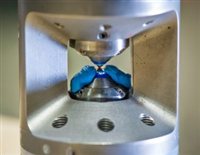Probing the Lower Size Limit of Dislocation Activity - Dr. Bin Chen
Chen is the lead and corresponding author of a paper in Science describing this work [Science, 338, 1448 (2012)]. The paper is titled “Texture of Nanocrystalline Nickel: Probing the Lower Size Limit of Dislocation Activity.” Co-authoring this paper were Katie Lutker, Selva Vennila Raju, Jinyuan Yan, Waruntorn Kanitpanyacharoen, Jialin Lei, Shizhong Yang, Hans-Rudolf Wenk, Ho-kwang Mao and Quentin Williams.
Bin Chen and Katie Lutker at ALS Beamline 12.2.2. (Photo by Roy Kaltschmidt)
Plastic deformation is a permanent change in the shape or size of a material as the result of an applied stress. The likelihood of plastic deformation increases with the presence of dislocations – defects or irregularities – within the material’s structure. Most materials are made up of small crystals, called “grains,” and what happens at the boundaries between these grains is critical to material properties. Based on computer simulations and electron microscopy analysis, the belief has been that dislocation-mediated plastic deformation becomes inactive below a grain size of at least 10 nanometers, and possibly as large as 30 nanometers.
“The idea was that below a critical length scale, dislocation-mediated deformation activity would give way to grain-boundary sliding, diffusion, and grain rotation,” Chen says. “However, there were many unresolved questions with regards to whether plasticity in ultrafine nanocrystalline grains could still be generated by dislocations and how pressure might affect the deformational regimes.”
To investigate grain size and pressure effects on the plastic deformation of nanometals, with radial diamond-anvil-cell X-ray diffraction techniques. Chen and his co-authors recorded in situ observations under a range of high pressures of texturing (when the crystalline grains have preferred orientations) in stressed polycrystalline nickel samples featuring grain sizes of 500-, 20- and 3-nanometers.
A radial diamond-anvil-cell allows for in situ X-ray diffraction experiments (Photo by Roy Kaltschmidt)
“Substantial texturing was observed at pressures above 3.0 gigapascals for nickel with 500-nanometer grain size and at greater than 11.0 gigapascals for nickel with 20-nanometer grain size,” Chen says. “Surprisingly, texturing was also seen in nickel with 3-nanometer grain size when compressed above 18.5 gigapascals. This tells us that under high external pressures, dislocation activity can be extended down to a few-nanometers-length scale.”
Chen and his co-authors are now applying their techniques to the study of other nanocrystalline materials, both metals and non-metals.
By Lynn Yarris, News Center, Berkeley Lab
Link to the paper published on Science:
http://www.sciencemag.org/content/338/6113/1448.short


